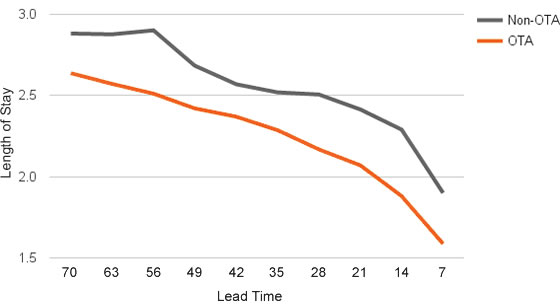
Last week we found that non-OTA bookers make their resort reservations 61% further in advance than guests who used OTAs. But lets dig deeper and add length-of-stay into the mix. Do resort guests (typically more leisure than business) who used OTAs stay fewer nights? Or if they stayed the same number of nights, did they really wait longer to book? Here’s what we found.
The Goods With this analysis we wanted to address two schools of thought. The first is that a traveler is driven by the window of time they have to travel. In other words, their length-of-stay is fixed and the rest revolves around that. So we began by grouping guests by their LOS and then found the average lead time for each group.
For example, the data points above “3″ on the horizontal axis below represent the average lead times of all people who booked a 3 night stay. The second concept is that a vacation is based primarily on a traveler’s personal timetable. In other words, their lead time is fixed and the rest revolves around that. So we also grouped bookers by their Lead time and found the average LOS for each group.
For example, the data points above “35″ on the horizontal axis below represent the average length-of-stay of all people who booked a 35 days in advance.
In both cases, however, the behavior of the OTA group is clearly seperated from the non-OTA group. People who booked through OTAs in our sample did so 20% later than people staying the same number of nights. People who booked through OTAs also stayed 14% fewer nights than people who booked as far in advance as they did.
What This Means When pricing experts talk about maintaining a healthy balance between OTAs and direct bookings, this is a big piece of what they are talking about. According to this sample, people booking resort stays through an OTA tend to stay fewer nights and wait longer to do so.


